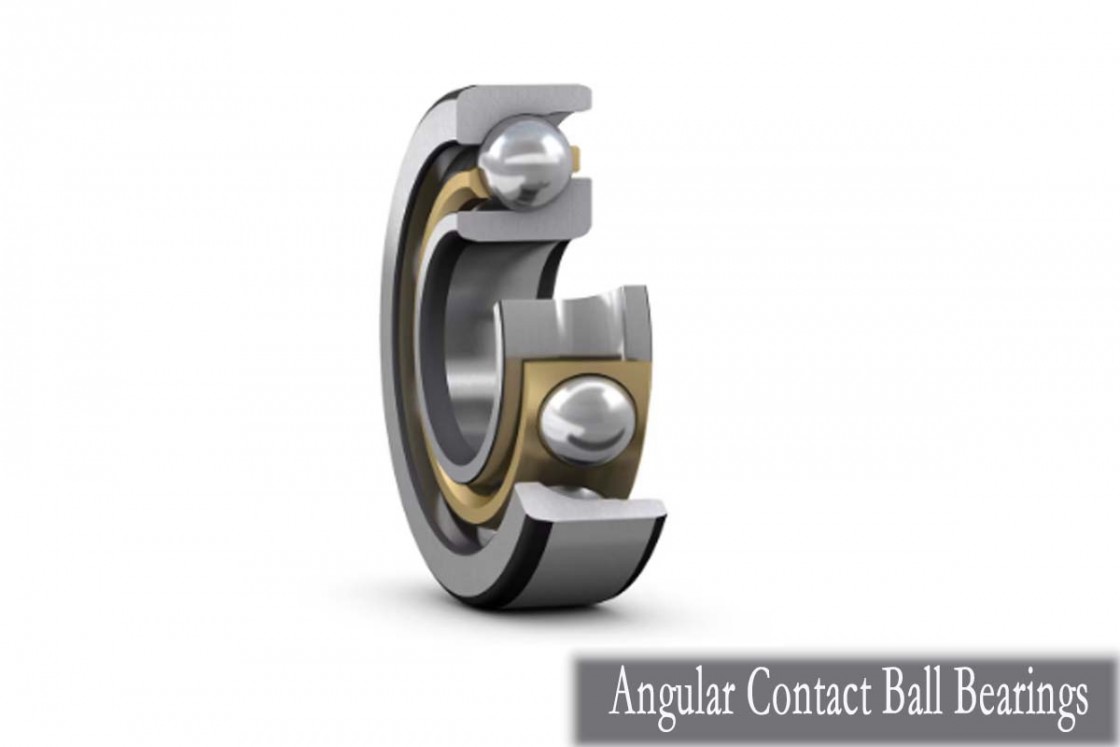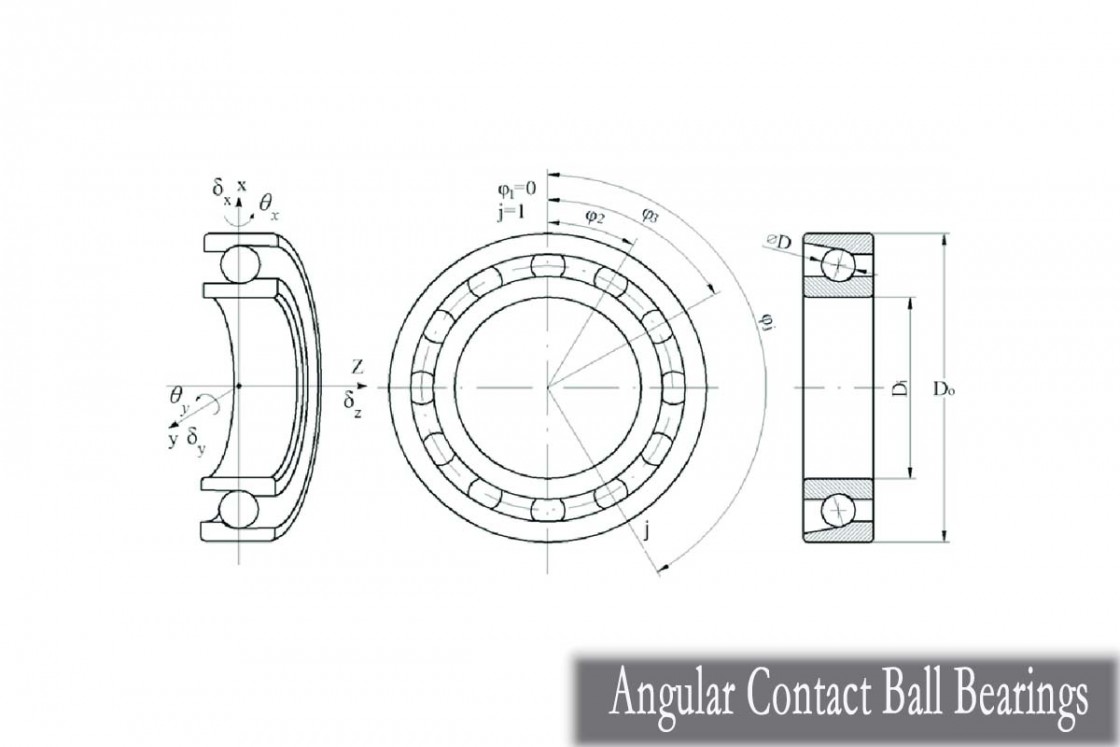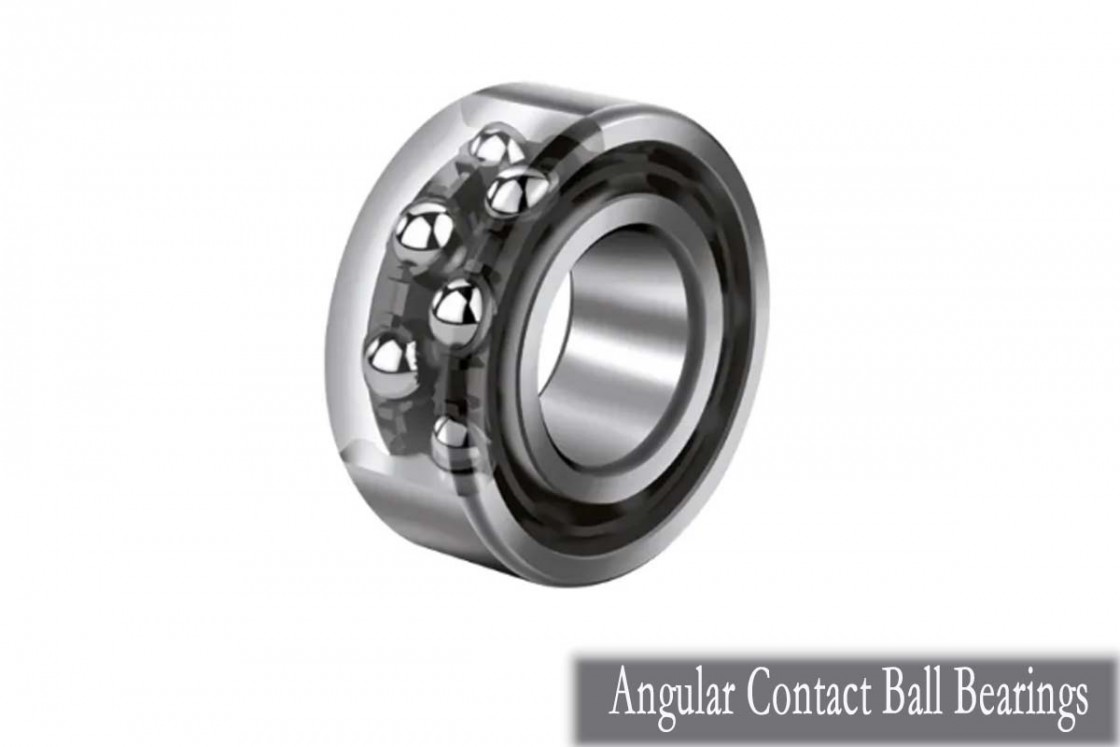Optimizing Efficiency: Maintenance Tips for Angular Contact Ball Bearings
In the dynamic world of industrial machinery and equipment, efficiency is paramount. As we strive to optimize performance and productivity, Angular Contact Ball Bearings (ACBBs) emerge as crucial components in achieving these goals.
Importance of Efficiency: Efficiency lies at the heart of every successful operation. Whether it's minimizing energy consumption, reducing downtime, or maximizing output, efficiency drives competitiveness and profitability in today's fast-paced industries.
Definition and Significance of ACBBs: Angular Contact Ball Bearings (ACBBs) are specialized bearings designed to accommodate combined radial and axial loads. Their unique angular contact design allows for high-speed operation and precise load distribution, making them indispensable in applications requiring high performance and reliability.

Understanding Angular Contact Ball Bearings
Angular Contact Ball Bearings (ACBBs) are precision-engineered components vital to the smooth operation of various industrial machinery. Let's delve into their structure, components, and applications to gain a comprehensive understanding.
Structure and Components: ACBBs consist of inner and outer rings, ball elements, and a cage or separator. The rings feature raceways designed to accommodate both radial and axial loads. The balls, typically made of steel, are arranged in a contact angle, allowing for optimized load distribution. The cage ensures proper ball spacing and alignment, contributing to smooth rotation.
Differentiation from Other Bearings: Unlike traditional ball bearings, ACBBs are uniquely engineered to handle combined radial and axial loads. Their angular contact design enables them to withstand higher thrust loads while maintaining operational efficiency. This distinguishes them from deep groove ball bearings and thrust ball bearings, which are optimized for specific load types.
Applications: ACBBs find extensive use in various industries, including automotive, aerospace, machine tools, and robotics. They are commonly employed in applications where precise positioning, high-speed operation, and load-carrying capacity are paramount. Examples include spindle assemblies, gearbox systems, and precision instruments.
In summary, understanding the intricacies of Angular Contact Ball Bearings (ACBBs) is essential for optimizing efficiency and performance in industrial machinery. Their unique design, capable of handling combined radial and axial loads, makes them indispensable components across a wide range of applications.

Maintenance Tips for Angular Contact Ball Bearings
Proper maintenance is crucial for ensuring the longevity and efficiency of Angular Contact Ball Bearings (ACBBs). Let's explore some essential tips to keep these precision components in optimal condition.
Importance of Proper Lubrication: Adequate lubrication is paramount for minimizing friction and preventing premature wear in ACBBs. Selecting the right lubricant based on factors such as speed, temperature, and load is essential. High-quality lubricants with the appropriate viscosity and additives help maintain smooth operation and extend bearing life.
Guidelines for Monitoring and Maintaining Preload: Preload, the internal axial load applied to ACBBs, affects their stiffness and performance. Regular monitoring and adjustment of preload ensure consistent operation and prevent issues such as excessive vibration and noise. Utilizing proper tools and techniques, such as preload gauges and torque wrenches, helps maintain optimal preload levels.
Techniques for Detecting and Addressing Issues: Detecting early signs of problems is crucial for preventing costly downtime and repairs. Regular inspections for indicators of wear, such as abnormal noise, vibration, or temperature, can help identify issues promptly. Addressing factors such as misalignment, inadequate lubrication, or overloading requires timely intervention to prevent damage to the bearings and associated machinery.
|
Brand |
Features |
Applications |
|
SKF |
- High-quality steel and advanced manufacturing processes <br> - Precision engineering for superior performance <br> - Wide range of sizes and designs <br> - Excellent reliability and long service life |
Aerospace, automotive, industrial machinery, wind turbines, pumps, compressors |
|
FAG |
- High-grade materials and precision engineering <br> - Innovative sealing solutions for enhanced protection <br> - Optimal contact angles for improved load capacity and speed <br> - Diverse product portfolio catering to various industries |
Automotive, aerospace, mining, construction, machine tools, railways |
|
NSK |
- Advanced technology and materials for durability <br> - Optimized internal geometry for reduced friction and heat generation <br> - Sealed and shielded options for contamination resistance <br> - Customizable designs for specific applications |
Robotics, automotive, medical equipment, agricultural machinery, construction machinery |
|
NTN |
- High-quality steel and heat treatment processes <br> - Precision machining for optimal performance <br> - Enhanced sealing and lubrication options <br> - Rigorous testing and quality control measures |
Automotive, industrial machinery, construction equipment, railway vehicles, wind turbines |
In conclusion, following these maintenance tips for Angular Contact Ball Bearings (ACBBs) is essential for optimizing efficiency and reliability in industrial applications. By prioritizing proper lubrication, preload maintenance, and proactive issue detection and resolution, you can ensure the smooth operation and longevity of ACBBs in your machinery and equipment.
This table provides a comparison of Angular Contact Ball Bearings (ACBBs) from prominent brands such as SKF, FAG, NSK, and NTN. Each brand offers distinct features and advantages tailored to various applications in industries such as aerospace, automotive, industrial machinery, and construction.
Installation and Handling Best Practices
Proper installation and handling are critical aspects of ensuring the optimal performance and longevity of Angular Contact Ball Bearings (ACBBs).
Step-by-Step Installation Guide:
Shaft and Housing Considerations: Before installation, carefully inspect the shaft and housing for any signs of damage, wear, or contamination. Ensure that they are clean, smooth, and properly aligned to prevent misalignment issues. Additionally, verify that the tolerances meet the manufacturer's specifications for a precise fit.
Mounting Procedure: Use precision tools and equipment to mount the ACBBs accurately. Apply a thin, even layer of the recommended lubricant to the bearing surfaces to reduce friction and facilitate smooth operation. Pay attention to the mounting orientation and follow the manufacturer's instructions for proper alignment and preload adjustment.
Secure Fastening: Ensure that the bearings are securely fastened to the shaft and housing using the appropriate fasteners and tightening torque. Over-tightening can cause damage to the bearings, while insufficient tightening may result in loosening during operation. Use calibrated torque wrenches to achieve the recommended torque values.
Handling Procedures to Prevent Contamination and Damage:
|
Clean Environment |
Handle ACBBs in a clean and controlled environment to prevent contamination by dirt, dust, or moisture. Use protective covers or packaging to shield the bearings from external elements during storage and transportation. |
|
Gentle Handling |
Exercise caution when handling ACBBs to avoid impact or shock loading, which can lead to damage or premature wear. Lift and move the bearings using appropriate lifting equipment or methods to prevent deformation or surface damage. |
|
Avoid Excessive Heat |
Minimize exposure to excessive heat sources during handling and installation, as high temperatures can degrade lubricants and affect bearing performance. Store the bearings in a cool, dry place away from direct sunlight and heat sources. |
In conclusion, following these installation and handling best practices is essential for optimizing the efficiency and reliability of Angular Contact Ball Bearings (ACBBs). By adhering to proper procedures and guidelines, you can ensure the smooth operation and longevity of ACBBs in your industrial machinery and equipment.
Environmental Factors and Protection
Angular Contact Ball Bearings (ACBBs) are vital components in various machinery and equipment across industries. However, their performance and longevity can be significantly affected by environmental factors such as temperature, humidity, and vibration., we'll delve into the impact of these factors on ACBBs and explore strategies to protect them from environmental stresses.
Impact of Environmental Conditions
|
Temperature |
Extreme temperatures can cause thermal expansion and contraction of bearing components, leading to premature wear and failure. High temperatures can degrade lubricants, reducing their effectiveness in lubricating the bearings. Conversely, low temperatures can increase friction and decrease the fluidity of lubricants. |
|
Humidity |
Moisture ingress can contaminate bearing surfaces and lubricants, promoting corrosion and reducing the effectiveness of lubrication. High humidity environments exacerbate these issues, increasing the risk of rust formation and accelerated wear. |
|
Vibration |
Vibrations, whether from machinery operation or external sources, can induce stress and fatigue in ACBBs, compromising their structural integrity over time. Excessive vibration levels can lead to premature bearing failure and necessitate frequent maintenance. |
Protective Measures
To mitigate the adverse effects of environmental conditions, various protective measures can be implemented:
Sealing and Shielding: Seals and shields provide a physical barrier between the bearing interior and the external environment, preventing contaminants such as dust, dirt, and moisture from entering. Sealed bearings are particularly effective in environments with high levels of contamination, while shielded bearings offer less protection but are more suitable for high-speed applications.
Lubrication: Proper lubrication is essential for reducing friction, dissipating heat, and preventing metal-to-metal contact within the bearing. Lubricants act as a protective layer, minimizing wear and corrosion. Selecting the right lubricant viscosity and replenishing it regularly are critical for maintaining optimal bearing performance.
Selection of Bearing Materials and Coatings
Choosing the appropriate materials and coatings for ACBBs is crucial for enhancing their resistance to environmental factors:
Corrosion-Resistant Materials: Stainless steel bearings or bearings with corrosion-resistant coatings are ideal for applications exposed to moisture or chemicals, offering enhanced durability and longevity.
High-Temperature Materials: In environments with elevated temperatures, bearings made from heat-resistant materials such as ceramic or specialized steel alloys can withstand thermal stresses more effectively.
Anti-Friction Coatings: Coatings such as ceramic or diamond-like carbon (DLC) can reduce friction and wear, extending the operating life of ACBBs in demanding conditions.
Conclusion
In conclusion, optimizing the efficiency and longevity of Angular Contact Ball Bearings requires careful consideration of environmental factors and the implementation of appropriate protective measures. By understanding the impact of temperature, humidity, and vibration on ACBB performance and selecting the right sealing, lubrication, and materials, manufacturers and operators can ensure reliable operation and minimal downtime in diverse operating environments.

Monitoring and Diagnostic Techniques
Angular Contact Ball Bearings (ACBBs) play a critical role in various industrial applications, and ensuring their optimal performance is essential for maximizing efficiency and productivity., we'll explore advanced monitoring and diagnostic techniques designed to detect early signs of bearing failure, establish proactive maintenance schedules, and prevent costly downtime.
Advanced Monitoring Techniques
Vibration Analysis: Vibration analysis is a powerful tool for assessing the condition of ACBBs. By measuring and analyzing the frequency and amplitude of vibrations generated by rotating machinery, engineers can identify abnormal patterns indicative of bearing defects, such as misalignment, unbalance, or bearing damage. Advanced vibration analysis techniques, such as spectral analysis and time waveform analysis, enable precise diagnosis and early detection of potential issues before they escalate into catastrophic failures.
Temperature Monitoring: Monitoring bearing temperature is another effective method for detecting abnormalities and potential failures. As bearings begin to degrade or experience excessive friction, they generate heat, leading to temperature fluctuations. Thermal imaging cameras or infrared thermometers can be used to monitor bearing temperature non-invasively. Sudden spikes or fluctuations in temperature can signal lubrication issues, excessive loading, or other mechanical problems requiring immediate attention.
Importance of Regular Inspection Intervals
Regular inspection intervals are crucial for proactive maintenance and early detection of potential issues. Establishing a comprehensive maintenance schedule based on operating conditions, environmental factors, and usage patterns ensures that ACBBs receive the necessary attention at appropriate intervals. Routine inspections should include visual checks, lubrication analysis, and diagnostic tests to assess bearing condition and performance accurately.
Utilization of Predictive Maintenance Strategies
Predictive maintenance strategies leverage advanced monitoring techniques and data analytics to predict and prevent potential failures before they occur. By collecting and analyzing real-time data on bearing performance, operating conditions, and environmental factors, predictive maintenance systems can identify abnormal patterns or deviations from normal operating parameters. This proactive approach enables maintenance teams to anticipate issues, schedule corrective actions, and minimize downtime, ultimately optimizing equipment efficiency and reliability.
Conclusion
In conclusion, monitoring and diagnostic techniques are indispensable tools for optimizing the efficiency and reliability of Angular Contact Ball Bearings. By leveraging advanced vibration analysis, temperature monitoring, and predictive maintenance strategies, manufacturers and operators can detect early signs of bearing failure, establish proactive maintenance schedules, and prevent costly downtime. Implementing these techniques not only enhances equipment performance but also extends bearing life, reduces maintenance costs, and ensures uninterrupted operation in critical industrial applications.
Case Studies and Real-World Examples
Angular Contact Ball Bearings (ACBBs) are vital components in a wide range of industrial applications, and the efficiency of their performance is paramount for ensuring seamless operations. we delve into real-world case studies and examples that illustrate the successful implementation of maintenance strategies tailored for ACBBs across diverse industries.
Manufacturing Sector
Background: A leading manufacturing facility specializing in heavy machinery utilized ACBBs in their production line. However, frequent equipment breakdowns and unplanned downtime were adversely affecting productivity and profitability.
Implementation: The maintenance team implemented a proactive maintenance strategy that included regular inspections, lubrication analysis, and vibration monitoring. They established a comprehensive maintenance schedule based on equipment usage and operating conditions.
Results: By adopting proactive maintenance practices, the facility experienced a significant reduction in equipment failures and unplanned downtime. The implementation of condition monitoring techniques allowed the early detection of potential issues, enabling timely corrective actions. As a result, the facility achieved improved equipment reliability, enhanced productivity, and substantial cost savings.
Aerospace Industry
Background: An aerospace manufacturing company relied on precision machinery equipped with ACBBs for critical machining processes. However, the challenging operating conditions, including high-speed rotation and heavy loads, posed maintenance challenges.
Implementation: The maintenance team introduced advanced monitoring techniques, such as temperature monitoring and predictive analytics, to assess bearing health and performance. They also implemented specialized lubrication regimes tailored to the demanding operational requirements.
Results: Through the proactive adoption of advanced monitoring and maintenance strategies, the aerospace company experienced a notable improvement in equipment performance and reliability. The predictive maintenance approach enabled the identification of potential failures before they occurred, minimizing the risk of unplanned downtime and costly repairs. The implementation of optimized lubrication practices also contributed to extending bearing life and reducing overall maintenance costs.
Conclusion
The case studies presented above underscore the importance of proactive maintenance strategies in optimizing the efficiency and reliability of Angular Contact Ball Bearings across different industries. By leveraging advanced monitoring techniques, establishing comprehensive maintenance schedules, and embracing predictive maintenance approaches, organizations can enhance equipment performance, minimize downtime, and achieve substantial cost savings. These real-world examples serve as valuable insights into the effective implementation of maintenance practices tailored for ACBBs, highlighting the significance of proactive maintenance in today's industrial landscape.
Conclusion
In conclusion, the maintenance of Angular Contact Ball Bearings (ACBBs) plays a pivotal role in optimizing efficiency and ensuring the smooth operation of industrial machinery. we have explored various maintenance tips and strategies tailored specifically for ACBBs, aimed at enhancing their performance and longevity.
Recap: Proper lubrication, regular inspections, monitoring techniques, and predictive maintenance are essential elements in the upkeep of ACBBs. By adhering to these maintenance practices, industries can mitigate the risk of premature failures and unexpected downtime, ultimately improving operational efficiency and productivity.
Importance of Proactive Maintenance: Proactive maintenance not only minimizes the risk of unexpected failures but also contributes to extending the lifespan of ACBBs. By implementing proactive maintenance measures, organizations can optimize their equipment's performance, reduce operational costs, and maximize return on investment.
Call to Action: It is imperative for industry professionals to prioritize ACBB maintenance as part of their overall reliability strategy. By investing in proactive maintenance practices and staying abreast of technological advancements in condition monitoring and predictive maintenance, organizations can ensure the continued efficiency and reliability of their equipment.
In conclusion, the efficient maintenance of Angular Contact Ball Bearings is essential for achieving optimal performance and minimizing downtime in industrial operations. By following the maintenance tips and strategies outlined in this article, industry professionals can effectively optimize the efficiency and reliability of ACBBs, thereby enhancing overall operational performance and productivity.
FAQs: Common Questions About Angular Contact Ball Bearings
we'll address some frequently asked questions (FAQs) related to Angular Contact Ball Bearings (ACBBs).
What are Angular Contact Ball Bearings (ACBBs)?
Angular Contact Ball Bearings are a type of precision bearing designed to accommodate combined radial and axial loads. They feature raceways inclined at an angle to the bearing axis, allowing them to support higher axial loads compared to radial ball bearings.
How do Angular Contact Ball Bearings differ from other types of bearings?
Unlike radial ball bearings that primarily support radial loads, ACBBs are optimized for both radial and axial loads. Their unique design allows for higher load capacities and greater stiffness, making them ideal for applications with varying load directions.
What are the main applications of Angular Contact Ball Bearings?
ACBBs are commonly used in machinery and equipment where high-speed operation and precise positioning are required, such as machine tools, aerospace applications, and automotive systems. They are also found in applications such as pumps, compressors, and gearboxes.
How can I properly maintain Angular Contact Ball Bearings?
Proper maintenance of ACBBs is crucial for optimizing efficiency and prolonging their lifespan. This includes regular lubrication, monitoring for signs of wear or damage, and ensuring proper installation and handling procedures are followed.
What factors should I consider when selecting Angular Contact Ball Bearings for my application?
When selecting ACBBs, factors such as load capacity, speed rating, precision, and operating conditions should be taken into account. It's essential to choose bearings that are suitable for the specific requirements of your application to ensure optimal performance and reliability.
What are the benefits of using Angular Contact Ball Bearings?
Some of the key benefits of ACBBs include their ability to support both radial and axial loads, high-speed capability, precision, and rigidity. They offer superior performance in applications where precise positioning and high rotational speeds are critical.
How can I troubleshoot common issues with Angular Contact Ball Bearings?
Common issues with ACBBs include excessive noise, vibration, and temperature rise. Troubleshooting techniques may involve inspecting for misalignment, inadequate lubrication, or bearing damage, and taking corrective action to address these issues promptly.
These FAQs provide insights into the features, applications, maintenance, and troubleshooting of Angular Contact Ball Bearings, helping users understand and optimize the performance of these critical components in various industrial applications.